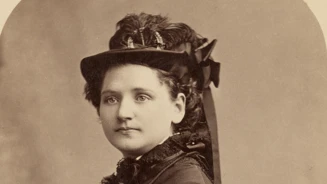Lady Cook: the American suffragist who fought for the women of America and Sintra
08 Mar 2023

Perhaps the name Tennessee Claflin won’t mean much to you, but if we talk about Lady Cook, you’ll probably know who she was. Did you know that Francis Cook's wife played a very important role in the development of the region's heritage and life?
Tennessee Claflin was born to a very poor family in Ohio in the 1840s. She was just a girl when, together with her sister Victoria, she began to support the family, posing as a fortune teller and healer, as well as organising séance performances. But things didn't always go well: In the work ‘Monserrate Revisited’, it reads: “In the worst case, Tennessee Claflin was charged with murder in 1864 after the death of a cancer patient following her hypnotic ‘treatments’. Tennessee immediately fled the state to escape the authorities”.
One of the people who resorted to the 'spiritual services' of these sisters was Cornelius Vanderbilt, an American tycoon who made his fortune in the merchant navy and in railroad construction. The businessman ended up becoming very close to the young Victoria Woodhull (married name, which she kept even after separating) and Tennessee Claflin who, in the 1870s, decided to move to New York, with the money from their new patron, to open their office - Woodhull, Claflin & Company. The two sisters thus became the first women to open a brokerage firm on Wall Street.
The company became an immediate success. Despite their integrity being called into question by publications such as the New York Times and Harper's Weekly, Tennessee and Victoria continued to prosper, to the point where they had the money to invest in creating a radical newspaper - Woodhull & Claflin's Weekly. This publication shocked everyone and everything: not only did it discuss controversial issues, such as the legalisation of prostitution, equal rights and the Free Love movement, which defended the separation between sex and marriage (which was also later used by hippies), but it also asserted itself when it came to political views, becoming the first newspaper in the United States to print the Communist Manifesto by Marx and Engels. The sisters even tried to launch a career in politics, with Victoria announcing a run for the White House, through the Equal Rights Party, and Tennessee for Congress.
“I don't care what society thinks... If I paid attention to what is said by what they call “society”, I would never be able to leave my apartment without being in a chic or formal dress; I despise what prim and prudish girls or arrogant dandies say about me... I think a woman is just as capable of earning her keep as a man... I focus on my business and that alone”, Tennessee Claflin told reporters, quoted in the book ‘Monserrate Revisited’.
(Below is a caricature of Victoria and Tennessee, published in 1870 in the ‘New York Evening Telegraph’)

But where does Sintra appear in the life of this American suffragist?
What actually happened was that Woodhull, Claflin & Company closed a few years after opening, following the economic depression that affected the United States at that time. The newspaper also ended up no longer being printed, following several scandals - the sisters were even arrested several times. With no direction in New York, they decided to go to London - it was in the British capital that Tennessee met Francis Cook, an English businessman and art collector.
With his fortune, Cook bought a large property in Sintra in 1846. There, he had a palace built that was very different from what already existed in Portugal, with Gothic, Indian and Moorish influences, as well as exotic and plant motifs, surrounded by a botanical garden unlike anything else that existed in Portugal, with species from all over the world. Thus, the Park and Palace of Monserrate was born.
It was here that the Cook family spent their holidays and organised large events, but the truth is that Monserrate also served the population. And that idea came about specifically from Tennessee Claflin - it was she who encouraged Francis Cook to allow the public to visit the Park and the Palace, including the interior of this summer residence, reverting the income from the tickets to the Santa Casa da Misericórdia of Sintra. This represented both a philanthropic action and the fulfilment of a cultural mission, by allowing all interested parties to appreciate the treasures of its botanical and artistic collections. The money raised by the Santa Casa was mainly used to build schools for young girls.
When Cook died in 1901, Claflin’s fragile position in European society became obvious when rumours surfaced that she had murdered her husband. These accusations turned out to be unfounded and no charges were ever brought against the widow. Cook's eldest son inherited Monserrate and Doughty House and Claflin received a generous pension, sufficient to live comfortably.
When she died in 1923, Tennessee Claflin was remembered in the ‘Chicago Tribune’ as a “reformist” in the United States and in Europe. “For part of her life, she dedicated a large portion of her time to active work in support of the suffragist cause, organising clubs, making generous financial donations and insisting on the need for more and better opportunities for women”, said the obituary.
